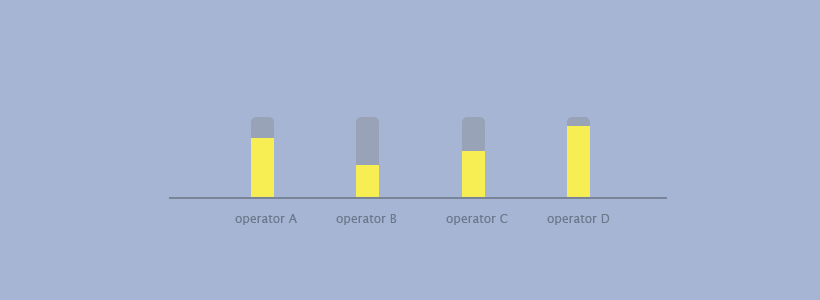In order to improve the customer service experience, the efficiency of your staff and the sustainability of your department, you need to understand how well your live chat agents are performing.
By understanding their work ethic, productivity and quality of service, you will be able to create a chat department that serves the needs of your customers and helps meet company goals.
An advanced live chat solution should have a series of reports to help you evaluate customer service performance by determining the productivity level of your agents and how well the incoming chats are being handled by your staff.
Customer Service Staff Needs to Be Available
Your employees may be on the clock, but that doesn’t mean that they are signed in to the chat system and working with visitors. It is important to analyze how many hours each agent spends interacting with other agents and clients or signed off as “Away” on the live chat monitor.
Another important aspect to review is how many chats do they accept during their shift versus how many they reject or pass off to other agents?This information will help you determine if you have live chat agents who are dedicated to the job and looking to help your customers and which ones are trying to avoid working by being logged in but setting their status so they don’t have to accept communications from visitors.
Remote Live Chat Agents Need to Stick to Hours
If you allow agents to work remotely or use mobile applications to communicate with customers, you need to make sure that they are adhering to the schedule you set for them and not just working any hours they want to.
Customers demand that if you say an agent is available within a specific period that they are able to speak to someone during those hours. If your remote staff isn’t online at the specified time then this could lead to your department being understaffed or unavailable when the office is supposed to be open.
Tracking when chat operators are logged in and working will help you ensure that your department is adequately staffed during the heaviest chat times. In addition, it may show you gaps where you need to add agents or even another shift to make sure that are available when customers are trying to contact you.
As a manager you can log into the live chat monitor and set your status so that chat operators and visitors aren’t alerted to your presence. You can then observe chats, see which of your operators are online and the communications between operators to ensure all customer queries are handled properly.
Another aspect to review with chat agents is to make sure they are notating the visitor logs and following company procedure.
Live chat creates a transcript of all chats initiated within the system. However, agents have the ability to add extra information to help create a more accurate picture of what happened during the chat. These notes are important and often can help gain insight into a customer.
Agents who neglect adding extra notes or their notes are incomplete are not being efficient and this can lead to problems with the customer in the future.
Live chat keeps a record of all the notes added to a customer chat as well as the agent who entered the information. If no notes are added, you can still see who the customer spoke with each time they participated in live chat with the company. If you see that one agent isn’t notating accounts correctly then you can discuss the situation with that agent.
Recommended for you: How to Go the Distance: Key Tips and Practices for Managing a Remote Live Chat Team
Can Your Customer Service Agents Multi-Task?
In order to leverage your staff, chat agents need to be able to handle multiple chats simultaneously.
As a manager, you can set the maximum number of chats each agent is sent at any one time. This way new agents aren’t overwhelmed and experienced agents are able solve issues faster and move on to the next chat.
If you want to know how many chats are being handled at the same time by an agent, you can view this information in reports. Linear chat time helps you view concurrent chats and not just the total number of chats a department received in a specific period.
Another important metric to consider is time visitors spend waiting in the waiting in the queue. You can control how visitors are routed to specific agents, however if all agents are already handling their maximum number of chats, then the visitors are asked to wait for the next available agent.
Live chat allows managers to see how long visitors are kept in the queue and how many chats are lost because the visitor left before the chat was accepted by an agent. This information is important to add to the statistics gathered to monitor call volume.
What Chat Volume Really Tells You
Total chats handled during a shift can tell you important information about the experience and work ethic of each agent.
The number of chats an agent handles during a day can indicate problem-solving skills. Chat volume can also indicate a good work ethic, especially if combined with a low “Away” rate on the live chat monitor.
And of course, the number of chats handled simultaneously shows experience, a good grasp of the company’s policies, and efficiency.
You do need to be careful because chat volume and chat quality need to go hand-in-hand. If customer service agents are just trying to get customers off the chat as quickly as possible to keep their numbers up then satisfaction will go down.
Are Customers Satisfied With Agent Performance?
Chat quality is vital to customer satisfaction. Allowing customers to rate agents’ performance will help you determine how well an agent is helping customers. You can create a post chat survey that will allow visitors rate their level of satisfaction with the agent and the company. Customers can rate an agent by giving them a specific number of stars during the chat or as soon as the chat is completed.
The information collected from the post chat survey is available in the report section of live chat so you can see how customers rate the level of service they receive.
Another indication of customer satisfaction is the number of chats they initiate. If a customer contacts the department multiple times, it can be because the agent isn’t solving the problem on the first chat.
First chat resolution is an important factor in customer satisfaction, and departments need to train agents so that they can aim for first chat resolution with every chat they handle.
The length of each chat can be an indication that an agent lacks the skill to resolve a situation quickly. While you don’t want to rush a visitor off a chat, you don’t want to have the chats run a long time either. This can lead to frustration on the part of the customer and your company is losing business because the agent in the middle of a long chat may not be able to handle other chats.
Several factors are involved with determining the performance level of your live chat agents. The agent’s availability, ability to multi-task, chat volume and customer satisfaction help you determine if the agents in your department have the skills to serve your customers. (Read our blog post for more performance metrics and how to use them.)
Download now: Agent Guide: Get the Best Customer Service Metrics in Your Team
This eBook contains all of the hints and tips live chat agents need to optimize their metrics, including average handle time, customer satisfaction, first contact resolution and sales figures.
Download Now
eBook







